LAW105: Negligence - Duty, Breach, Causation and Accountant Liability
VerifiedAdded on 2023/01/03
|7
|1727
|65
Essay
AI Summary
This essay provides a comprehensive analysis of negligence within the framework of business law, specifically addressing the crucial elements of duty of care, breach of duty, and causation of harm. It begins by defining negligence as the failure to exercise reasonable care, detailing the necessary components for a successful claim. The essay delves into the concept of duty of care, differentiating between general and special duties, and explores the evolution of the duty of care through landmark cases such as Donoghue v. Stevenson and Caparo Industries Plc v. Dickman. The discussion extends to the breach of duty, examining how it is determined and the factors considered in assessing it. Furthermore, the essay investigates causation of harm, including the application of the 'but for' test. A significant portion of the essay is dedicated to professional negligence, particularly concerning accountants. It outlines the duty of care owed by accountants to their clients, common errors leading to negligence claims, and the legal principles governing accountant liability, supported by relevant case law like Boyd v. Ackley and Candler v. Crane, Christmas & Co. The essay concludes by emphasizing the importance of adhering to professional standards and ethical conduct in the accounting profession to mitigate negligence risks.
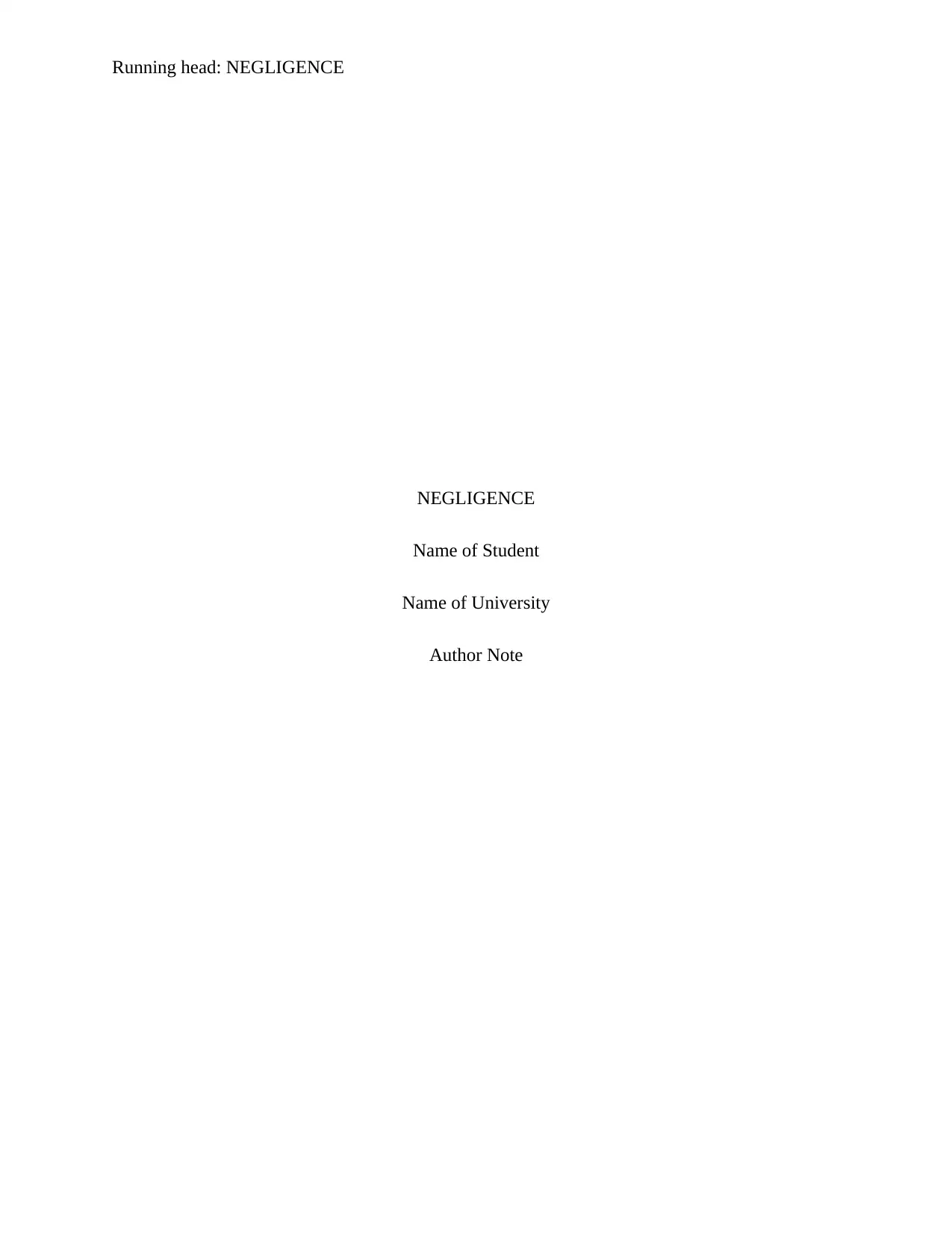
Running head: NEGLIGENCE
NEGLIGENCE
Name of Student
Name of University
Author Note
NEGLIGENCE
Name of Student
Name of University
Author Note
Paraphrase This Document
Need a fresh take? Get an instant paraphrase of this document with our AI Paraphraser
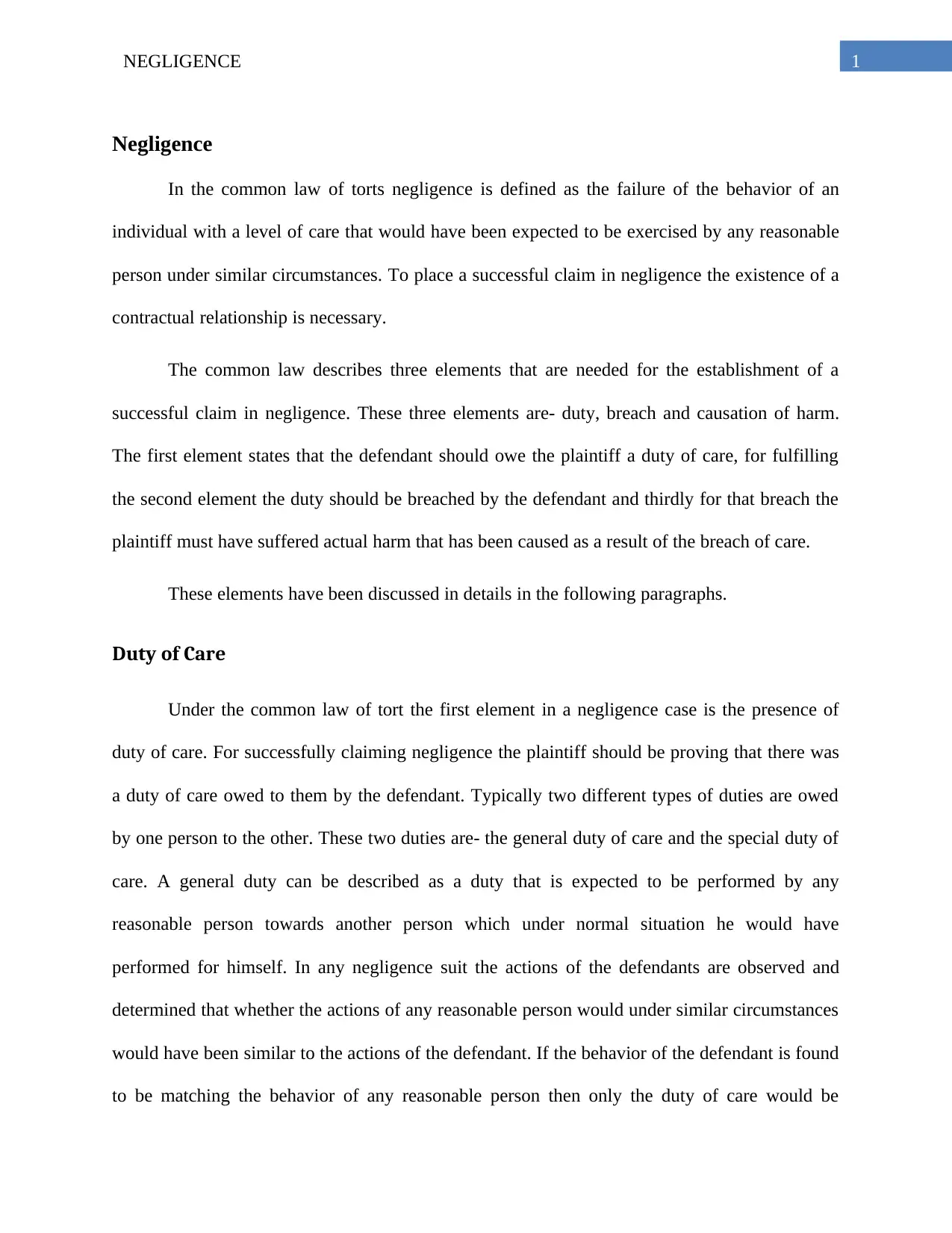
1NEGLIGENCE
Negligence
In the common law of torts negligence is defined as the failure of the behavior of an
individual with a level of care that would have been expected to be exercised by any reasonable
person under similar circumstances. To place a successful claim in negligence the existence of a
contractual relationship is necessary.
The common law describes three elements that are needed for the establishment of a
successful claim in negligence. These three elements are- duty, breach and causation of harm.
The first element states that the defendant should owe the plaintiff a duty of care, for fulfilling
the second element the duty should be breached by the defendant and thirdly for that breach the
plaintiff must have suffered actual harm that has been caused as a result of the breach of care.
These elements have been discussed in details in the following paragraphs.
Duty of Care
Under the common law of tort the first element in a negligence case is the presence of
duty of care. For successfully claiming negligence the plaintiff should be proving that there was
a duty of care owed to them by the defendant. Typically two different types of duties are owed
by one person to the other. These two duties are- the general duty of care and the special duty of
care. A general duty can be described as a duty that is expected to be performed by any
reasonable person towards another person which under normal situation he would have
performed for himself. In any negligence suit the actions of the defendants are observed and
determined that whether the actions of any reasonable person would under similar circumstances
would have been similar to the actions of the defendant. If the behavior of the defendant is found
to be matching the behavior of any reasonable person then only the duty of care would be
Negligence
In the common law of torts negligence is defined as the failure of the behavior of an
individual with a level of care that would have been expected to be exercised by any reasonable
person under similar circumstances. To place a successful claim in negligence the existence of a
contractual relationship is necessary.
The common law describes three elements that are needed for the establishment of a
successful claim in negligence. These three elements are- duty, breach and causation of harm.
The first element states that the defendant should owe the plaintiff a duty of care, for fulfilling
the second element the duty should be breached by the defendant and thirdly for that breach the
plaintiff must have suffered actual harm that has been caused as a result of the breach of care.
These elements have been discussed in details in the following paragraphs.
Duty of Care
Under the common law of tort the first element in a negligence case is the presence of
duty of care. For successfully claiming negligence the plaintiff should be proving that there was
a duty of care owed to them by the defendant. Typically two different types of duties are owed
by one person to the other. These two duties are- the general duty of care and the special duty of
care. A general duty can be described as a duty that is expected to be performed by any
reasonable person towards another person which under normal situation he would have
performed for himself. In any negligence suit the actions of the defendants are observed and
determined that whether the actions of any reasonable person would under similar circumstances
would have been similar to the actions of the defendant. If the behavior of the defendant is found
to be matching the behavior of any reasonable person then only the duty of care would be
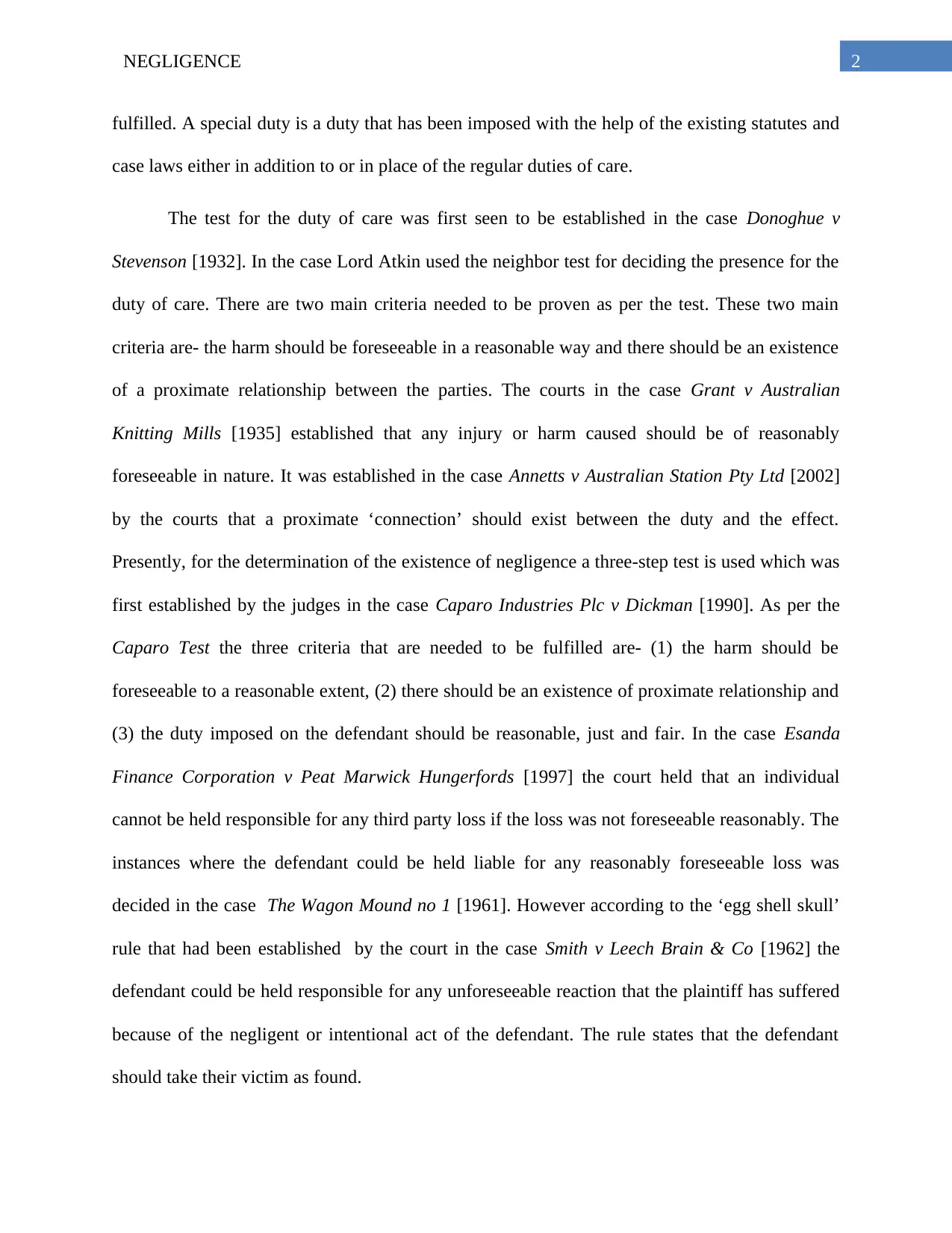
2NEGLIGENCE
fulfilled. A special duty is a duty that has been imposed with the help of the existing statutes and
case laws either in addition to or in place of the regular duties of care.
The test for the duty of care was first seen to be established in the case Donoghue v
Stevenson [1932]. In the case Lord Atkin used the neighbor test for deciding the presence for the
duty of care. There are two main criteria needed to be proven as per the test. These two main
criteria are- the harm should be foreseeable in a reasonable way and there should be an existence
of a proximate relationship between the parties. The courts in the case Grant v Australian
Knitting Mills [1935] established that any injury or harm caused should be of reasonably
foreseeable in nature. It was established in the case Annetts v Australian Station Pty Ltd [2002]
by the courts that a proximate ‘connection’ should exist between the duty and the effect.
Presently, for the determination of the existence of negligence a three-step test is used which was
first established by the judges in the case Caparo Industries Plc v Dickman [1990]. As per the
Caparo Test the three criteria that are needed to be fulfilled are- (1) the harm should be
foreseeable to a reasonable extent, (2) there should be an existence of proximate relationship and
(3) the duty imposed on the defendant should be reasonable, just and fair. In the case Esanda
Finance Corporation v Peat Marwick Hungerfords [1997] the court held that an individual
cannot be held responsible for any third party loss if the loss was not foreseeable reasonably. The
instances where the defendant could be held liable for any reasonably foreseeable loss was
decided in the case The Wagon Mound no 1 [1961]. However according to the ‘egg shell skull’
rule that had been established by the court in the case Smith v Leech Brain & Co [1962] the
defendant could be held responsible for any unforeseeable reaction that the plaintiff has suffered
because of the negligent or intentional act of the defendant. The rule states that the defendant
should take their victim as found.
fulfilled. A special duty is a duty that has been imposed with the help of the existing statutes and
case laws either in addition to or in place of the regular duties of care.
The test for the duty of care was first seen to be established in the case Donoghue v
Stevenson [1932]. In the case Lord Atkin used the neighbor test for deciding the presence for the
duty of care. There are two main criteria needed to be proven as per the test. These two main
criteria are- the harm should be foreseeable in a reasonable way and there should be an existence
of a proximate relationship between the parties. The courts in the case Grant v Australian
Knitting Mills [1935] established that any injury or harm caused should be of reasonably
foreseeable in nature. It was established in the case Annetts v Australian Station Pty Ltd [2002]
by the courts that a proximate ‘connection’ should exist between the duty and the effect.
Presently, for the determination of the existence of negligence a three-step test is used which was
first established by the judges in the case Caparo Industries Plc v Dickman [1990]. As per the
Caparo Test the three criteria that are needed to be fulfilled are- (1) the harm should be
foreseeable to a reasonable extent, (2) there should be an existence of proximate relationship and
(3) the duty imposed on the defendant should be reasonable, just and fair. In the case Esanda
Finance Corporation v Peat Marwick Hungerfords [1997] the court held that an individual
cannot be held responsible for any third party loss if the loss was not foreseeable reasonably. The
instances where the defendant could be held liable for any reasonably foreseeable loss was
decided in the case The Wagon Mound no 1 [1961]. However according to the ‘egg shell skull’
rule that had been established by the court in the case Smith v Leech Brain & Co [1962] the
defendant could be held responsible for any unforeseeable reaction that the plaintiff has suffered
because of the negligent or intentional act of the defendant. The rule states that the defendant
should take their victim as found.
⊘ This is a preview!⊘
Do you want full access?
Subscribe today to unlock all pages.

Trusted by 1+ million students worldwide
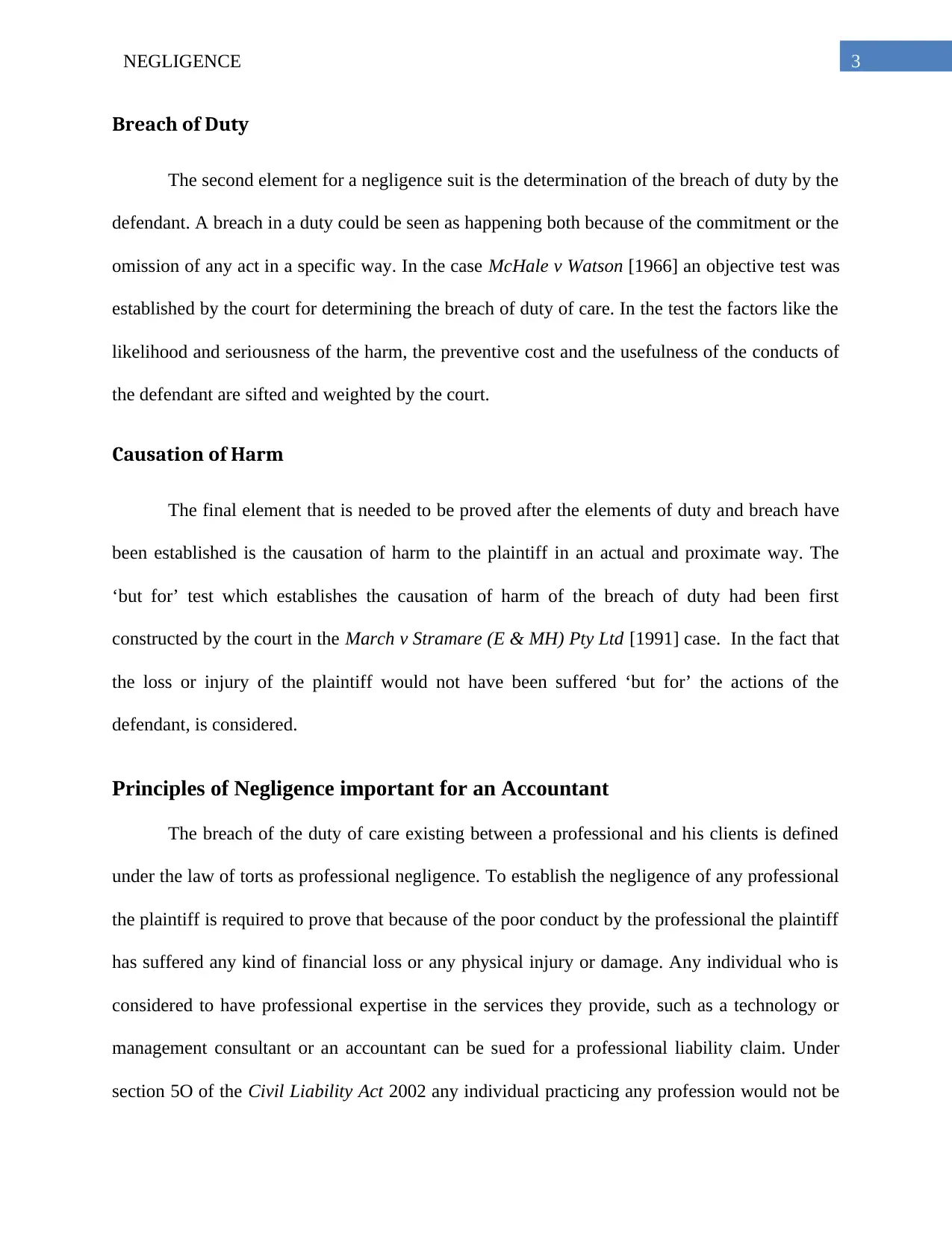
3NEGLIGENCE
Breach of Duty
The second element for a negligence suit is the determination of the breach of duty by the
defendant. A breach in a duty could be seen as happening both because of the commitment or the
omission of any act in a specific way. In the case McHale v Watson [1966] an objective test was
established by the court for determining the breach of duty of care. In the test the factors like the
likelihood and seriousness of the harm, the preventive cost and the usefulness of the conducts of
the defendant are sifted and weighted by the court.
Causation of Harm
The final element that is needed to be proved after the elements of duty and breach have
been established is the causation of harm to the plaintiff in an actual and proximate way. The
‘but for’ test which establishes the causation of harm of the breach of duty had been first
constructed by the court in the March v Stramare (E & MH) Pty Ltd [1991] case. In the fact that
the loss or injury of the plaintiff would not have been suffered ‘but for’ the actions of the
defendant, is considered.
Principles of Negligence important for an Accountant
The breach of the duty of care existing between a professional and his clients is defined
under the law of torts as professional negligence. To establish the negligence of any professional
the plaintiff is required to prove that because of the poor conduct by the professional the plaintiff
has suffered any kind of financial loss or any physical injury or damage. Any individual who is
considered to have professional expertise in the services they provide, such as a technology or
management consultant or an accountant can be sued for a professional liability claim. Under
section 5O of the Civil Liability Act 2002 any individual practicing any profession would not be
Breach of Duty
The second element for a negligence suit is the determination of the breach of duty by the
defendant. A breach in a duty could be seen as happening both because of the commitment or the
omission of any act in a specific way. In the case McHale v Watson [1966] an objective test was
established by the court for determining the breach of duty of care. In the test the factors like the
likelihood and seriousness of the harm, the preventive cost and the usefulness of the conducts of
the defendant are sifted and weighted by the court.
Causation of Harm
The final element that is needed to be proved after the elements of duty and breach have
been established is the causation of harm to the plaintiff in an actual and proximate way. The
‘but for’ test which establishes the causation of harm of the breach of duty had been first
constructed by the court in the March v Stramare (E & MH) Pty Ltd [1991] case. In the fact that
the loss or injury of the plaintiff would not have been suffered ‘but for’ the actions of the
defendant, is considered.
Principles of Negligence important for an Accountant
The breach of the duty of care existing between a professional and his clients is defined
under the law of torts as professional negligence. To establish the negligence of any professional
the plaintiff is required to prove that because of the poor conduct by the professional the plaintiff
has suffered any kind of financial loss or any physical injury or damage. Any individual who is
considered to have professional expertise in the services they provide, such as a technology or
management consultant or an accountant can be sued for a professional liability claim. Under
section 5O of the Civil Liability Act 2002 any individual practicing any profession would not be
Paraphrase This Document
Need a fresh take? Get an instant paraphrase of this document with our AI Paraphraser
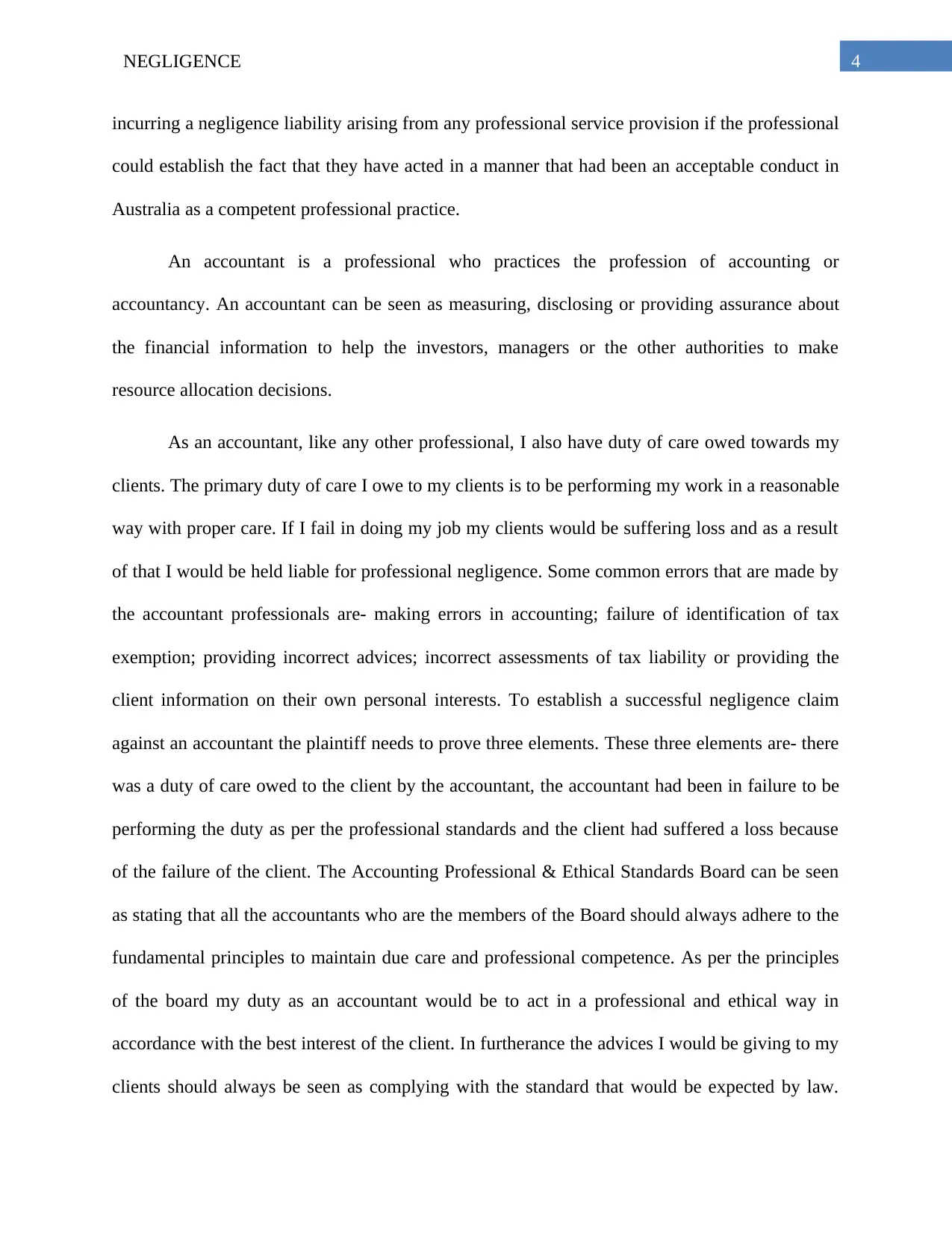
4NEGLIGENCE
incurring a negligence liability arising from any professional service provision if the professional
could establish the fact that they have acted in a manner that had been an acceptable conduct in
Australia as a competent professional practice.
An accountant is a professional who practices the profession of accounting or
accountancy. An accountant can be seen as measuring, disclosing or providing assurance about
the financial information to help the investors, managers or the other authorities to make
resource allocation decisions.
As an accountant, like any other professional, I also have duty of care owed towards my
clients. The primary duty of care I owe to my clients is to be performing my work in a reasonable
way with proper care. If I fail in doing my job my clients would be suffering loss and as a result
of that I would be held liable for professional negligence. Some common errors that are made by
the accountant professionals are- making errors in accounting; failure of identification of tax
exemption; providing incorrect advices; incorrect assessments of tax liability or providing the
client information on their own personal interests. To establish a successful negligence claim
against an accountant the plaintiff needs to prove three elements. These three elements are- there
was a duty of care owed to the client by the accountant, the accountant had been in failure to be
performing the duty as per the professional standards and the client had suffered a loss because
of the failure of the client. The Accounting Professional & Ethical Standards Board can be seen
as stating that all the accountants who are the members of the Board should always adhere to the
fundamental principles to maintain due care and professional competence. As per the principles
of the board my duty as an accountant would be to act in a professional and ethical way in
accordance with the best interest of the client. In furtherance the advices I would be giving to my
clients should always be seen as complying with the standard that would be expected by law.
incurring a negligence liability arising from any professional service provision if the professional
could establish the fact that they have acted in a manner that had been an acceptable conduct in
Australia as a competent professional practice.
An accountant is a professional who practices the profession of accounting or
accountancy. An accountant can be seen as measuring, disclosing or providing assurance about
the financial information to help the investors, managers or the other authorities to make
resource allocation decisions.
As an accountant, like any other professional, I also have duty of care owed towards my
clients. The primary duty of care I owe to my clients is to be performing my work in a reasonable
way with proper care. If I fail in doing my job my clients would be suffering loss and as a result
of that I would be held liable for professional negligence. Some common errors that are made by
the accountant professionals are- making errors in accounting; failure of identification of tax
exemption; providing incorrect advices; incorrect assessments of tax liability or providing the
client information on their own personal interests. To establish a successful negligence claim
against an accountant the plaintiff needs to prove three elements. These three elements are- there
was a duty of care owed to the client by the accountant, the accountant had been in failure to be
performing the duty as per the professional standards and the client had suffered a loss because
of the failure of the client. The Accounting Professional & Ethical Standards Board can be seen
as stating that all the accountants who are the members of the Board should always adhere to the
fundamental principles to maintain due care and professional competence. As per the principles
of the board my duty as an accountant would be to act in a professional and ethical way in
accordance with the best interest of the client. In furtherance the advices I would be giving to my
clients should always be seen as complying with the standard that would be expected by law.
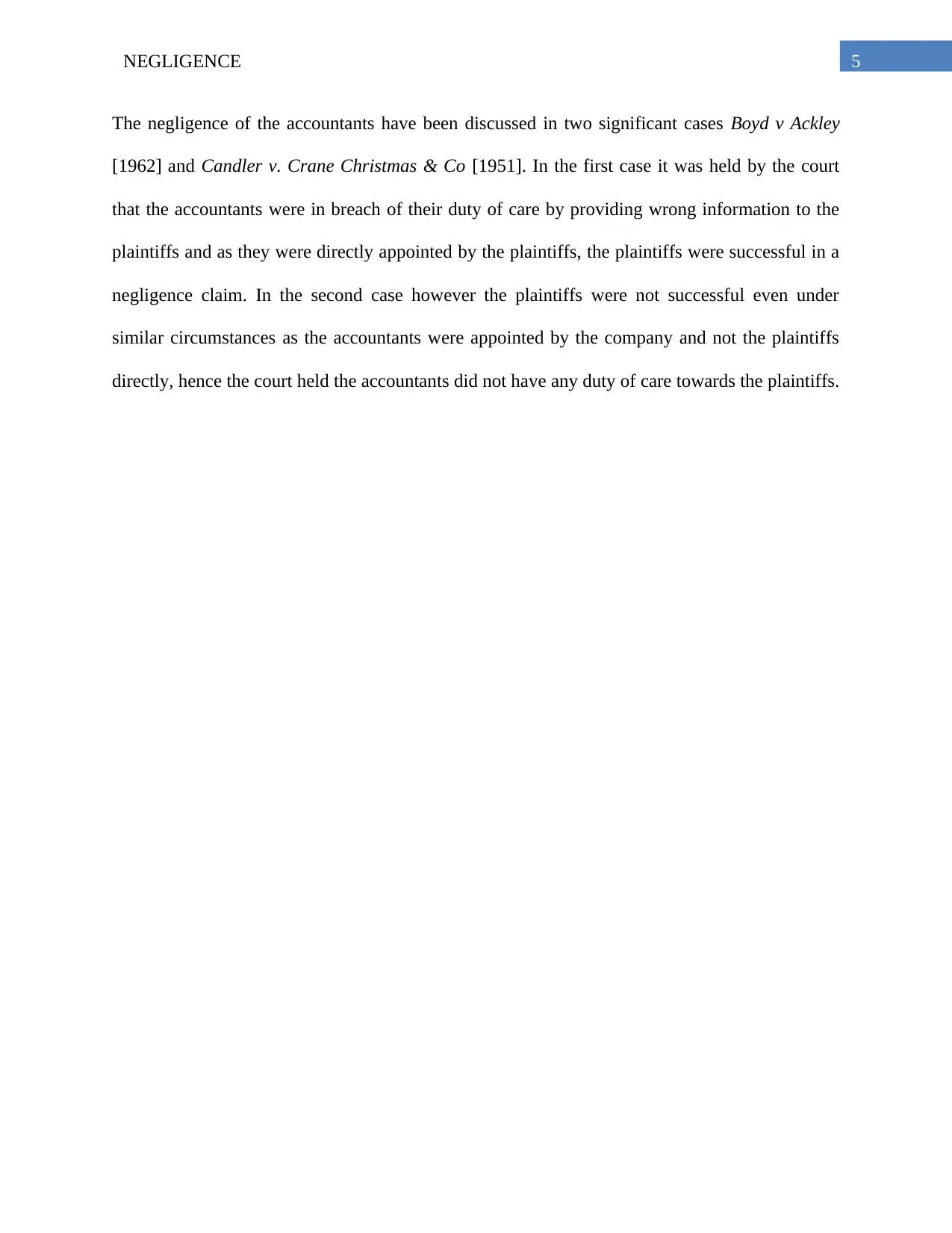
5NEGLIGENCE
The negligence of the accountants have been discussed in two significant cases Boyd v Ackley
[1962] and Candler v. Crane Christmas & Co [1951]. In the first case it was held by the court
that the accountants were in breach of their duty of care by providing wrong information to the
plaintiffs and as they were directly appointed by the plaintiffs, the plaintiffs were successful in a
negligence claim. In the second case however the plaintiffs were not successful even under
similar circumstances as the accountants were appointed by the company and not the plaintiffs
directly, hence the court held the accountants did not have any duty of care towards the plaintiffs.
The negligence of the accountants have been discussed in two significant cases Boyd v Ackley
[1962] and Candler v. Crane Christmas & Co [1951]. In the first case it was held by the court
that the accountants were in breach of their duty of care by providing wrong information to the
plaintiffs and as they were directly appointed by the plaintiffs, the plaintiffs were successful in a
negligence claim. In the second case however the plaintiffs were not successful even under
similar circumstances as the accountants were appointed by the company and not the plaintiffs
directly, hence the court held the accountants did not have any duty of care towards the plaintiffs.
⊘ This is a preview!⊘
Do you want full access?
Subscribe today to unlock all pages.

Trusted by 1+ million students worldwide
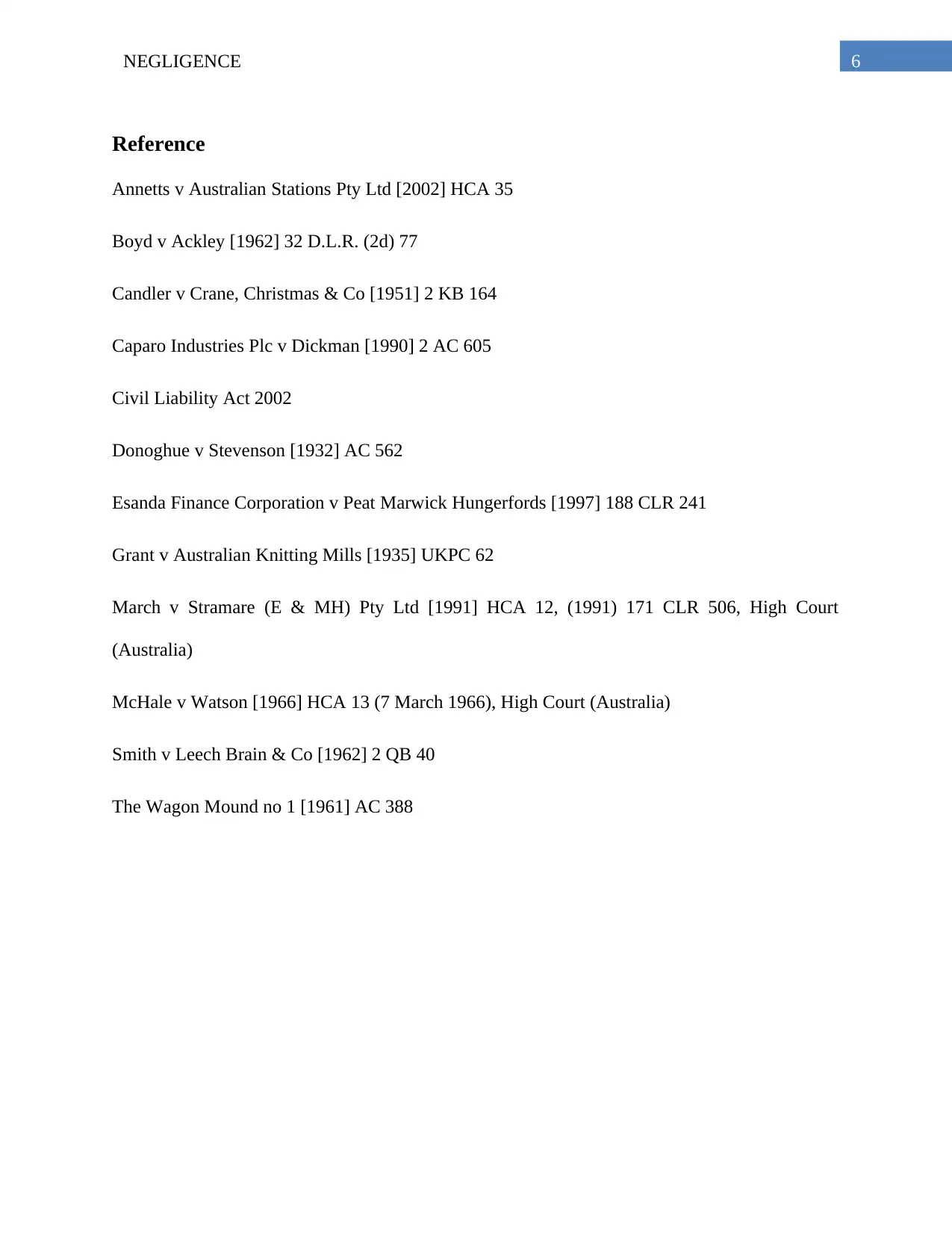
6NEGLIGENCE
Reference
Annetts v Australian Stations Pty Ltd [2002] HCA 35
Boyd v Ackley [1962] 32 D.L.R. (2d) 77
Candler v Crane, Christmas & Co [1951] 2 KB 164
Caparo Industries Plc v Dickman [1990] 2 AC 605
Civil Liability Act 2002
Donoghue v Stevenson [1932] AC 562
Esanda Finance Corporation v Peat Marwick Hungerfords [1997] 188 CLR 241
Grant v Australian Knitting Mills [1935] UKPC 62
March v Stramare (E & MH) Pty Ltd [1991] HCA 12, (1991) 171 CLR 506, High Court
(Australia)
McHale v Watson [1966] HCA 13 (7 March 1966), High Court (Australia)
Smith v Leech Brain & Co [1962] 2 QB 40
The Wagon Mound no 1 [1961] AC 388
Reference
Annetts v Australian Stations Pty Ltd [2002] HCA 35
Boyd v Ackley [1962] 32 D.L.R. (2d) 77
Candler v Crane, Christmas & Co [1951] 2 KB 164
Caparo Industries Plc v Dickman [1990] 2 AC 605
Civil Liability Act 2002
Donoghue v Stevenson [1932] AC 562
Esanda Finance Corporation v Peat Marwick Hungerfords [1997] 188 CLR 241
Grant v Australian Knitting Mills [1935] UKPC 62
March v Stramare (E & MH) Pty Ltd [1991] HCA 12, (1991) 171 CLR 506, High Court
(Australia)
McHale v Watson [1966] HCA 13 (7 March 1966), High Court (Australia)
Smith v Leech Brain & Co [1962] 2 QB 40
The Wagon Mound no 1 [1961] AC 388
1 out of 7
Related Documents
Your All-in-One AI-Powered Toolkit for Academic Success.
+13062052269
info@desklib.com
Available 24*7 on WhatsApp / Email
![[object Object]](/_next/static/media/star-bottom.7253800d.svg)
Unlock your academic potential
Copyright © 2020–2025 A2Z Services. All Rights Reserved. Developed and managed by ZUCOL.





